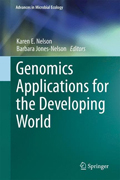
Genomics applications for the developing world
Nelson, Karen E.
Jones-Nelson, Barbara
This book evolved from the editors strong belief that the information and newdevelopments that were evolving from the rapidly growing field of genomics and that are happening primarily in the developed world have not happened at a parallel rate in the developing world. One would have hoped that by now the technologies and approaches would have been adapted on a far greater scale. In addition to this, the associated information is not always easily accessible, and is not disseminated in a format that can become a useful reference for scientists, students and others who reside in developing countries. This series of short monographs captures information on relevant topics and discusses how genomics can be applied to improve on existing conditions. Aims to collate views from leaders in the field who are primarily based in the developing world. Targeted towards genomics applications of developing world problems. INDICE: Part I: Introduction. Chapter 1. Genomics and the Developing World. Chapter 2. Application of Genetic and Genomic Tests in the Developing World. Part II: Microbial Pathogen Genomes. Chapter 3. The Genomics of Cholera. Chapter 4. The Genomics of Leprosy. Chapter 5. Pathogen genomics and the potential for understanding diseases in the developing world. Chapter 6. New Tuberculosis Drugs. Part III: Viruses. Chapter 7. Viral genomics: implications for the understanding and control of emerging viral diseases. Part IV:Eukaryotic Disease. Chapter 8. Malaria Genomics and the Developing World. Chapter 9. Delivering on promises? The Impact of Kinetoplastid Genomics on Sleeping Sickness, Chagas Disease and Leishmaniasis. Part V:Pharmacogenomics. Chapter 10. Pharmacogenomic Applications in the Developing World - The American Continent. Chapter 11. Pharmacogenomics in Africa: Diversity as an opportunity for personalized healthcare. Chapter 12. Pharmacogenomics in Developing Asian Countries. Part VI:New Frontiers. Chapter 13. Microbial diversity of the Brazilian biomes (Atlantic Forest, Amazon ‘Rain’ Forest, Cerrado, and the Marine realm). Chapter 14. Genetic Diversity of Microbial Endophytes and Their Biotechnical Applications. Chapter 15. Genomics and potential Bioenergy Applications In the Developing World. Chapter 16. Molecules with the potential for cancer therapy in the developing world: Dibenzyl Trisulfide(DTS). Chapter 17. The effect of diet on gut microbiota in humans living in different environments: a metagenomic approach. Part VII: Plant Genomes. Chapter 18. Analyzing the Papaya Genome. Part VIII: Education. Chapter 19. The global challenge of genomics education: A path to the future. Chapter 20. Genomics and potential downstream applications in the Developing World. .
- ISBN: 978-1-4614-2181-8
- Editorial: Springer US
- Encuadernacion: Cartoné
- Páginas: 361
- Fecha Publicación: 30/04/2012
- Nº Volúmenes: 1
- Idioma: Inglés
